+ Open data
Open data
- Basic information
Basic information
| Entry | Database: PDB / ID: 7btp | ||||||
|---|---|---|---|---|---|---|---|
| Title | EcoR124I-Ocr in Restriction-Alleviation State | ||||||
 Components Components |
| ||||||
 Keywords Keywords | IMMUNE SYSTEM / Cryoelectron microscopy / Innate immune mechanism / Complex | ||||||
| Function / homology |  Function and homology information Function and homology informationtype I site-specific deoxyribonuclease / type I site-specific deoxyribonuclease activity / symbiont-mediated evasion of host restriction-modification system / N-methyltransferase activity / site-specific DNA-methyltransferase (adenine-specific) / site-specific DNA-methyltransferase (adenine-specific) activity / DNA restriction-modification system / methylation / symbiont-mediated suppression of host innate immune response / DNA binding / ATP binding Similarity search - Function | ||||||
| Biological species |    Escherichia phage T7 (virus) Escherichia phage T7 (virus) | ||||||
| Method | ELECTRON MICROSCOPY / single particle reconstruction / cryo EM / Resolution: 4.01 Å | ||||||
 Authors Authors | Gao, Y. / Gao, P. | ||||||
 Citation Citation |  Journal: Nat Microbiol / Year: 2020 Journal: Nat Microbiol / Year: 2020Title: Structural insights into assembly, operation and inhibition of a type I restriction-modification system. Authors: Yina Gao / Duanfang Cao / Jingpeng Zhu / Han Feng / Xiu Luo / Songqing Liu / Xiao-Xue Yan / Xinzheng Zhang / Pu Gao /  Abstract: Type I restriction-modification (R-M) systems are widespread in prokaryotic genomes and provide robust protection against foreign DNA. They are multisubunit enzymes with methyltransferase, ...Type I restriction-modification (R-M) systems are widespread in prokaryotic genomes and provide robust protection against foreign DNA. They are multisubunit enzymes with methyltransferase, endonuclease and translocase activities. Despite extensive studies over the past five decades, little is known about the molecular mechanisms of these sophisticated machines. Here, we report the cryo-electron microscopy structures of the representative EcoR124I R-M system in different assemblies (RMS, RMS and MS) bound to target DNA and the phage and mobile genetic element-encoded anti-restriction proteins Ocr and ArdA. EcoR124I can precisely regulate different enzymatic activities by adopting distinct conformations. The marked conformational transitions of EcoR124I are dependent on the intrinsic flexibility at both the individual-subunit and assembled-complex levels. Moreover, Ocr and ArdA use a DNA-mimicry strategy to inhibit multiple activities, but do not block the conformational transitions of the complexes. These structural findings, complemented by mutational studies of key intermolecular contacts, provide insights into assembly, operation and inhibition mechanisms of type I R-M systems. | ||||||
| History |
|
- Structure visualization
Structure visualization
| Movie |
 Movie viewer Movie viewer |
|---|---|
| Structure viewer | Molecule:  Molmil Molmil Jmol/JSmol Jmol/JSmol |
- Downloads & links
Downloads & links
- Download
Download
| PDBx/mmCIF format |  7btp.cif.gz 7btp.cif.gz | 518.5 KB | Display |  PDBx/mmCIF format PDBx/mmCIF format |
|---|---|---|---|---|
| PDB format |  pdb7btp.ent.gz pdb7btp.ent.gz | 406.3 KB | Display |  PDB format PDB format |
| PDBx/mmJSON format |  7btp.json.gz 7btp.json.gz | Tree view |  PDBx/mmJSON format PDBx/mmJSON format | |
| Others |  Other downloads Other downloads |
-Validation report
| Summary document |  7btp_validation.pdf.gz 7btp_validation.pdf.gz | 958.8 KB | Display |  wwPDB validaton report wwPDB validaton report |
|---|---|---|---|---|
| Full document |  7btp_full_validation.pdf.gz 7btp_full_validation.pdf.gz | 983.2 KB | Display | |
| Data in XML |  7btp_validation.xml.gz 7btp_validation.xml.gz | 66.5 KB | Display | |
| Data in CIF |  7btp_validation.cif.gz 7btp_validation.cif.gz | 103.4 KB | Display | |
| Arichive directory |  https://data.pdbj.org/pub/pdb/validation_reports/bt/7btp https://data.pdbj.org/pub/pdb/validation_reports/bt/7btp ftp://data.pdbj.org/pub/pdb/validation_reports/bt/7btp ftp://data.pdbj.org/pub/pdb/validation_reports/bt/7btp | HTTPS FTP |
-Related structure data
| Related structure data |  30181MC  7bstC  7btoC  7btqC  7btrC M: map data used to model this data C: citing same article ( |
|---|---|
| Similar structure data |
- Links
Links
- Assembly
Assembly
| Deposited unit | 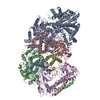
|
|---|---|
| 1 |
|
- Components
Components
| #1: Protein | Mass: 46235.773 Da / Num. of mol.: 1 Source method: isolated from a genetically manipulated source Source: (gene. exp.)   | ||
|---|---|---|---|
| #2: Protein | Mass: 120278.859 Da / Num. of mol.: 1 Source method: isolated from a genetically manipulated source Source: (gene. exp.)   References: UniProt: Q304R3, UniProt: P10486*PLUS, type I site-specific deoxyribonuclease | ||
| #3: Protein | Mass: 58077.090 Da / Num. of mol.: 2 Source method: isolated from a genetically manipulated source Source: (gene. exp.)   References: UniProt: P10484, site-specific DNA-methyltransferase (adenine-specific) #4: Protein | Mass: 13819.015 Da / Num. of mol.: 2 Source method: isolated from a genetically manipulated source Source: (gene. exp.)   Escherichia phage T7 (virus) / Gene: 0.3 / Production host: Escherichia phage T7 (virus) / Gene: 0.3 / Production host:  |
-Experimental details
-Experiment
| Experiment | Method: ELECTRON MICROSCOPY |
|---|---|
| EM experiment | Aggregation state: PARTICLE / 3D reconstruction method: single particle reconstruction |
- Sample preparation
Sample preparation
| Component | Name: EcoR124I-Ocr / Type: COMPLEX / Entity ID: all / Source: RECOMBINANT |
|---|---|
| Source (natural) | Organism:  |
| Source (recombinant) | Organism:  |
| Buffer solution | pH: 7.5 |
| Specimen | Embedding applied: NO / Shadowing applied: NO / Staining applied: NO / Vitrification applied: YES |
| Vitrification | Cryogen name: ETHANE |
- Electron microscopy imaging
Electron microscopy imaging
| Experimental equipment |  Model: Titan Krios / Image courtesy: FEI Company |
|---|---|
| Microscopy | Model: FEI TITAN KRIOS |
| Electron gun | Electron source:  FIELD EMISSION GUN / Accelerating voltage: 300 kV / Illumination mode: FLOOD BEAM FIELD EMISSION GUN / Accelerating voltage: 300 kV / Illumination mode: FLOOD BEAM |
| Electron lens | Mode: BRIGHT FIELD |
| Image recording | Electron dose: 60 e/Å2 / Film or detector model: GATAN K2 SUMMIT (4k x 4k) |
- Processing
Processing
| CTF correction | Type: PHASE FLIPPING AND AMPLITUDE CORRECTION |
|---|---|
| 3D reconstruction | Resolution: 4.01 Å / Resolution method: FSC 0.143 CUT-OFF / Num. of particles: 197498 / Symmetry type: POINT |
 Movie
Movie Controller
Controller












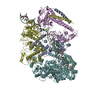



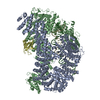

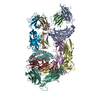
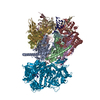
 PDBj
PDBj